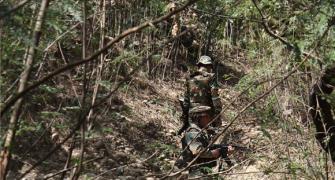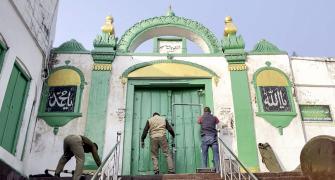
'There is simply no evidence of any new or clear policy direction in internal security, and mounting evidence of policy incoherence.'
'Worse, the promise of giving the common man -- and, more importantly, woman -- a greater sense of security has been utterly belied. Indeed, with an escalation of communal posturing and rhetoric, there is a broader sense of uncertainty,' says Ajai Sahni.
The difficulty with an extraordinary victory is that it comes with extraordinary expectations, and is often followed by quick disappointment. This appears to be the predicament of Prime Minister Narendra Modi's government as it completes a year.
While its backers argue that the government has achieved more in this single year than the preceding United Progressive Alliance had in a decade, and trot out a range of decisions and data to validate their claims, detractors can focus only on what has not been done, on the perceived gap between promise and delivery.
On internal security parameters, difficulties of assessment are compounded by broad trends that were already in place before the current regime took over. Thus, there has been tremendous improvement in most theatres of chronic conflict over at least the past five years (and much more in some).
According to the South Asia Terrorism Portal, the country recorded 1,902 terrorism and insurgency related fatalities in 2010, but this number was down to 976 in 2014; another 251 fatalities have been recorded in 2015, till May 10.
Crucially, terrorism and insurgency linked fatalities across the country had peaked at 5,839 in 2001. In Jammu and Kashmir, 2014 saw 193 fatalities, as against a peak of 4,507 in 2001. In the North-East, insurgency-linked fatalities in 2014 stood at 465, as against a peak of 1,317 in 2001 and 1,051 in 2009. Maoist violence claimed 314 lives in 2014, as against 1,180 in 2010.
But the trends have been far from smooth, and the Modi era has seen a relative worsening across several theatres. In J&K, fatalities had dropped to 117 in 2012, but rose to 181 in 2013, and further, to 193 in 2014. Another 40 people have already been killed in 2015 (till May 10).
The multiple insurgencies of the North-East, similarly, have seen a drop from a peak of 1,051 fatalities in 2008, to 465 in 2014, but the latter figure represents a significant increase over the 252 killed in 2013. 108 persons have already been killed in the North-East in the current year (till May 10).
It is only in the case of Left-wing extremism that clear gains are visible, with violence collapsing from a peak of 1,180 fatalities in 2010, 602 in 2011, 367 in 2012, spiking to 421 in 2013, and down, again, at 314 in 2014. Left-wing extremism violence has claimed 92 lives in 2015 (till May 10).
The sheer randomness of trends in insurgent violence indicate that neither success nor failure can be attributed to the Modi government, and that inertial motion, rather than focused policy initiatives, are at play.
The trends demonstrate clear continuities with the past and imply that little has changed with the advent of the Modi Sarkar, notwithstanding the aggressive posturing and loud pre-election assertions of dramatic transformations in internal security.
There is simply no evidence of any new or clear policy direction, and unfortunately mounting evidence of policy incoherence. There has, of course, been much theatre, the swings of the pendulum between talks and no talks with Pakistan, dramatic statements of sweeping transformations in the North-East, and prime ministerial visits to Kashmir, Maoist heartland areas and the long-ignored North-Eastern states, among others.
Far from suggesting determination and a clear direction, these various acts and initiatives, with little follow-up or lasting impact on the ground, reinforce the impression of incoherence. Indeed, Arun Shourie's assertion, in another context, that 'the government seems to be more concerned with managing headlines than putting policies in place,' applies with great accuracy and urgency to the internal security situation.
Crucially, there has been no significant improvement in the structure or functioning of the Indian security establishment. Periodic operational successes have, of course, continued, with intelligence and enforcement agencies arresting and neutralising various cells of Pakistan-backed terrorists, Maoist and North-Eastern insurgents, in a process that has been ongoing since years. None of this can, however, be tied to any specific policies, capacity building or institutional changes initiated by the Modi government.
Worse, the promise of giving the common man -- and, more importantly, woman -- a greater sense of security has been utterly belied. Indeed, with an escalation of communal posturing and rhetoric, there is a broader sense of uncertainty, ironically at a time when communal violence is actually registering a declining trend.
Continuing and often bizarre incidents of street violence, crimes against women and rage induced excesses, with no significant improvement in police responses, have fed into a collective psyche dominated by fear and uncertainty.
The general law and order situation demonstrates little evidence of any remarkable change. There has been no visible improvement in the sphere of women's security, in the management of communal and caste tensions, or in other spheres of public safety.
Significantly, the Nirbhaya Fund of Rs 1,000 crore (Rs 10 billion) allocated for women's security by the United Progressive Alliance government in 2013 remains unspent. This has not, however, deterred the present government from allocating another Rs 1,000 crore to the fund in the 2015-2016 Union Budget.
Through all this, police reforms, long overdue and crucial for all aspects of internal security, remain an area of enduring neglect. If anything, some of the current government's steps in this context are explicitly retrograde.
The Centre has actually slashed about Rs 8 billion from funding for key police infrastructure -- construction and upgrading of police stations, police housing, forensic science laboratories and training facilities -- in states under the modernisation of police force scheme, though the Union ministry of home affairs was allocated Rs 621.24 billion in the Union Budget for 2015-2016, a 10.2 per cent increase over the outlay in last fiscal (2014-2015), with focus on internal security.
Critical projects that have missed endless deadlines continue to languish under the new dispensation as well. The Crime and Criminal Tracking Network and Systems project, which was intended to link more than 14,000 police stations and 6,000 higher offices in the police hierarchy -- perhaps the single most crucial initiative in the internal security sphere -- which has been floundering for the past six years since it was first sanctioned in 2009, received no allocation in the latest Union Budget.
The scheme now 'stands transferred to states,' who are expected to fund it from their 'increased share of Union taxes' -- a formulation that inspires little confidence.
Significantly, several Opposition-ruled states are already questioning the Union government's claim of 'increased share of Union taxes'. CCTNS -- a recasting of the 'Polnet' project sanctioned in 1996 -- was envisaged by the UPA government in 2009, in the aftermath of the 26/11 Mumbai terror attacks.
A range of other projects, including NatGrid, the GPS system for surveillance of sea vessels, capacity augmentation in central intelligence agencies, and critical technological and equipment upgrades, remained stalled.
Fortunately, there is an equal silence on P Chidambaram's pet project, the misconceived National Counter-terrorism Centre. Modi had expressed his clear and principled opposition to this project while he was chief minister and, though there are many in his administration who support this extravagant fantasy, no one appears to have found the courage to bell the cat.
Further, little has been done to address the over 22.81 per cent deficit of personnel in the police, against severely inadequate sanctioned strengths, including a 19.7 per cent in the elite Indian Police Service ranks, or the gaping manpower shortages in the principal central intelligence establishments.
India is a lumbering, elephantine State, and cannot be expected to pivot around on its heels, irrespective of the skill and intentions of its present mahout.
A year is a mere moment in history, and Modi has another four to go in his current term. There will still be many opportunities for him to address the appalling internal security situation in India, but it will take an extraordinary effort of will, sagacity and sustained focus if anything tangible is to be achieved.
There is already significant evidence of mounting public disappointment in the Modi government, and a failure to address pressing issues of internal security can prove crucial to a complete loss of popular faith.
Ajai Sahni is Executive Director, Institute for Conflict Management & South Asia Terrorism Portal.









